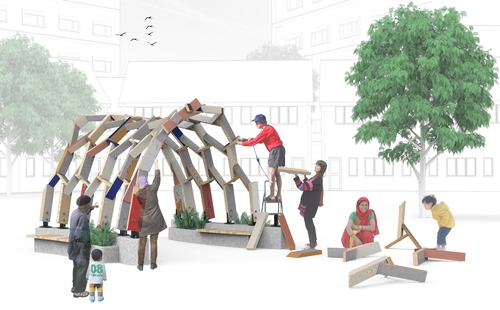Case Study #2: ‘Once their windows, now our playground’
Onderdeel van
Trefwoorden
Large renovation projects offer interesting possibilities for circular wood. Imagine upgrading a whole neighborhood, with several high-rise apartment buildings from the 60’s. There, circular wood can be harvested in bigger volumes because many standard doors, doorframes and window frames come available at the same time. What could re-using this wood entail, if it was destined to upgrade the neighborhood? Could something for the community be created to strengthen the social fabric, which is often needed in these locations. This might encourage tenants take better care of their building, feeling connected to the place, which represents a positive impact for corporations too. This case study explores the design and production of a community outdoor structure, considering a specific stock of uneven wooden beams.

Design from Availability
In this case study, digital design and robotic production methods are integrated as a flexible tool. Algorithms optimize how to ‘fit’ a stock of circular wooden beams to a desired shape, arranging them as a spatial frame with variable connection nodes. Every node is different, yet that’s no problem for production: industrial robots can easily saw, mill and drill wooden beams, given variable angles and lengths. This design and production flexibility can also include tenants in a creative dialog, to co-design their community structure. In this concept, the processing of beams and nodes is like fabricating a kit of custom parts. When all elements are pre-fabricated and tagged by robots, it can be built together with local tenants.
---
This case study is part of the 'Circular Wood for the Neighborhood' project, done at the ROBOT LAB and lead by the Digital Production Research Group (DPRG) of the Knowledge Center Technology, Amsterdam University of Applied Sciences (AUAS).
Afbeelding credits
Icon afbeelding: RenderCS2.jpg